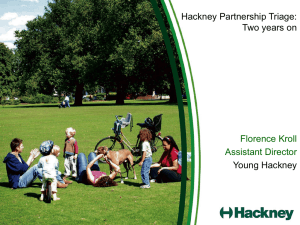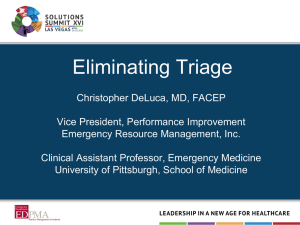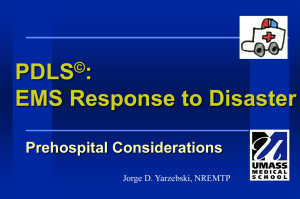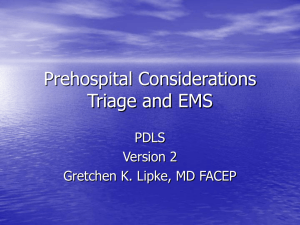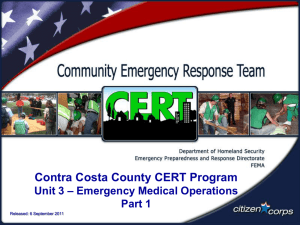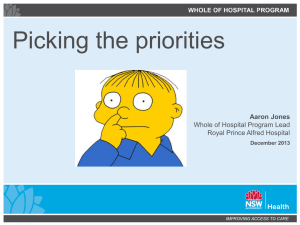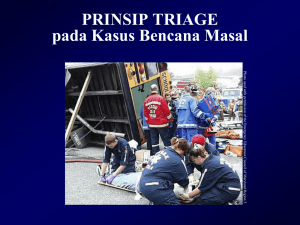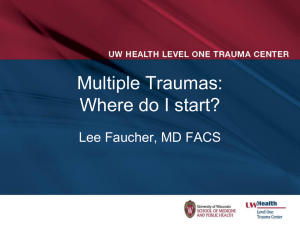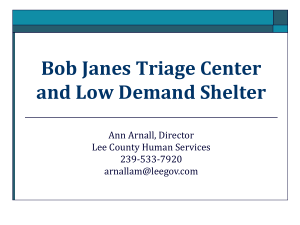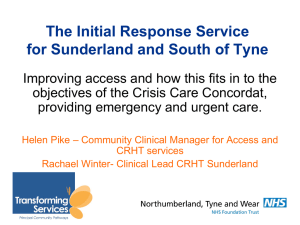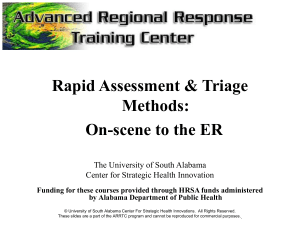2-General Principles
advertisement
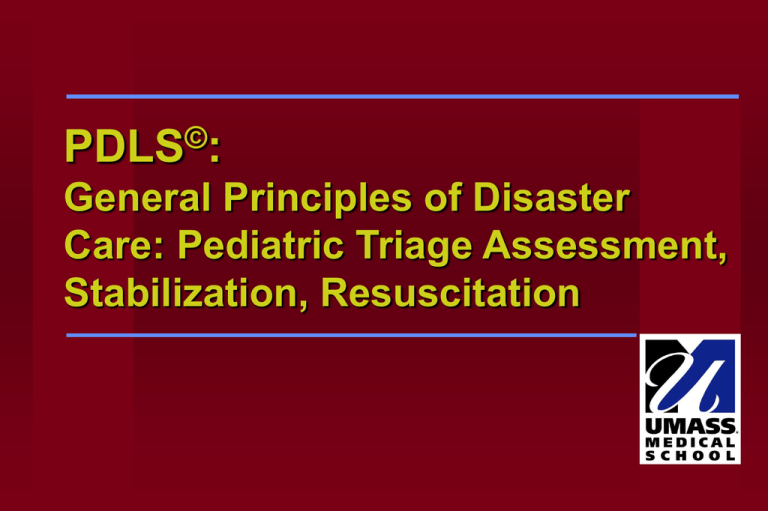
PDLS©: General Principles of Disaster Care: Pediatric Triage Assessment, Stabilization, Resuscitation Triage Assessment, Stabilization, Resuscitation Learning Objective At the end of this lecture, the students should be able to: - describe differences in triage decision making for children - describe triage categories - describe field triage assessment - describe principles of field triage, stabilization and - resuscitation describe initial field stabilization methods for children describe organization of field triage, treatment, staging, and clearing/transportation for children Oklahoma City – YMCA Day Care The Scene: - Multiple injured kids - Delay in finding them - 4 Children: 2 not breathing, unresponsive 2 sitting, crying General Principles of Disaster Care Triage Assessment Initial Stabilization Resuscitation Triage Assessment Derived from the French “trier” meaning to sort, it describes a medical decision making process. Appropriate performance crucial. Dynamic process, re-triage / re-evaluate at several stages. Determination of priority may effect the extent and quality of care the patient receives. Triage Triage in disaster setting may be very difficult Pediatric population unique challenge Problems of Under / Over-Triage Triage in Prehospital Setting ICS (Incident Command System) - Medical Branch Gain Control of Scene Triage Officer: Initial Brief Assessment Initial Evaluation Ensure scene safety Establish that disaster exists Estimate number of victims: adults/children Initial Evaluation Notification to medical control: regional communications, local emergency management / disaster authority - type of event - initial casualty estimate Make initial request for additional resources Then begin triage assessment of individual patients Initial Brief Assessment Open airway Control major hemorrhage Categorize Triage Categories Red / Immediate / Emergency Yellow / Urgent Green / Non-Urgent / Walking Wounded Black / Blue Triage Classifications Simple Triage And Rapid Treatment S.T.A.R.T. JumpSTART Tool for Rapid Pediatric Multicasualty Field Triage (children from 1 - 8 years of age) Triage Classifications and Examples Red - tension pneumothorax, rib fractures, upper airway obstruction, hemorrhage, femur fracture, asthmatic Yellow - humerus fracture, scalp lacerations, shoulder dislocation Green - ankle sprain, simple laceration, orphaned child, subluxed radial head Black/Blue - cardiopulmonary arrest, severe open head injury Triage Classifications Consider pediatric anatomy / physiology / age / development when categorizing child Familiarity with - level of expertise of personnel - numbers and type of transport available - equipment supplies - appropriate destination for definitive care Initial Patient Assessment Primary Survey of Child Airway - patency Breathing - rate, quality C irculation: Pulse check - quality, rate D isability: Mental status Exposure Airway First priority even more so than in an adult. Hypoxia main factor leading to organ dysfunction, ischemia, and cardiopulmonary arrest. Consider need for endotracheal intubation in child with GCS<8, significant maxillofacial trauma, aspiration, or respiratory distress. Remember - Oropharyngeal airway - ET size/uncuffed - ET route for delivery of medication (LANE) Breathing Children consume oxygen x 2 that of adult Assess: respiratory rate (infants 40/min, preschool 30/min, school 20/min) Effort Auscultate, percuss Thoracic cage and rib fractures Tension pneumothorax Circulation Normal values: infant 160/min, preschool 140/min, school 120/min. Systolic BP 80+ (age in years x 2) Assess: - capillary refill temperature of extremities color of patient Circulating blood volume: neonate 90 ml/kg, infant 80 ml/kg, older child 70 ml/kg, adult 65-70 mg/kg Bradycardia requires immediate attention, most common cause is hypoxia, but acidosis and hypovolemia are also factors. IV Access Attempt peripheral access if unsuccessful in < 90 sec. consider IO or cutdown. Estimated body weight: (age in yr.. x 2) + 10 Blood volume = 80 mls/kg x body weight Estimate blood loss: # pelvic ring = 10% total blood volume, # femur up to 20%. IO access sites - distal femur - proximal tibia - med/lat malleolus - iliac crests High success rate, up to 80% in less than one minute Consider IV Access in the Following: Time to definitive care 30-60 minutes Prolonged extrication / entrapment Dehydration > 15% Multiple fractures Scalp lacerations with significant blood loss Children After Burns Airway and ventilation a priority in management. Cover burn area in a clean sheet and wrap patient in a clean blanket. Calculate percentage burn Consider specialized facility for following: - 2/3 degree > 10% - 2/3 degree face, hands, feet, genitalia, perineum, and major joints - 3 degree > 5% - electrical burns - inhalation injury - preexisting medical problems - associated trauma in which burn injury > risk Disability GCS useful in children > 1yr Exposure Examine the entire child Hypothermia may occur secondary to exposure, sepsis, shock, and may lead to metabolic acidosis, decreased respiration, bradycardia and cardiac arrest. Newborns at high risk. What are your plans for newborns, infants who have no guardians? Field Stabilization Airway - chin lift, jaw thrust, oro- or nasopharyngeal airway Breathing - supplemental O2 as available - limited resources for mechanical/manual ventilation Circulation - hemorrhage control - direct pressure, dressings (rotating tourniquets) - limited resources for IVF Fracture Stabilization - using resources available Field Stabilization There is little role for initiation of CPR in disaster situations Consider on site organization of arriving personnel and arriving resources Consider establishment of clearing/staging unti: - triage patients for treatment on site or transport to hospital/health care facility - efficient utilization of resources, personnel, and supplies Resuscitation/Stabilization Simple measures that do not require sophisticated equipment are most appropriate. Needs must be evaluated and balanced against available resources. The principle of “doing the greatest good for the greatest number”. Pediatric Trauma Score Score Size Airway Systolic BP CNS Skeletal Cutaneous +2 >20 kg N >90 mmHg awake none none +1 10-20 kg maintainable 30-90 mmHg obtunded/LOC closed # minor -1 <10 kg unmaintainable <30 mmHg coma/decerebrate open/multiple # major/penetrating trauma Useful as a triage tool in the multiple injured child. Score <8 = need for advance level of care, high risk category ~ 30% mortality >8 = community hospital capable of treating children Child Likely To Need Specialized Care Shock SBP <80, HR>130<50 Resp distress RR>30<10, stridor GCS<9 Mechanism - MVA - Pedestrian/bicyclist thrown >15 feet - Penetrating injury to head, neck, trunk Child Likely To Need Specialized Care Specific injuries skull # pneumothorax, flail chest abd trauma with peritoneal signs amputation / degloving vascular injury burn with inhalation FB aspiration / ingestion Preplanning Needs assessment of community Commitment on part of institutions and key personnel to treating injured children Consider children with special needs Consider evacuation process for NICU/PICU/SCU for newborns Lack of supervision Requirement of children in shelters Categorize the Following 7 y.o. female, crying, unwilling to move right arm, 1° burn to anterior thigh 10 y.o. male, deformed thigh, pale, pulse 120, BP 30/40, RR 30 20 y.o. female, apneic, severe head injury with visible grey matter 2 y.o. male, 2-3° burns to face, neck and chest 5 day old infant, found on ground, appears unharmed

